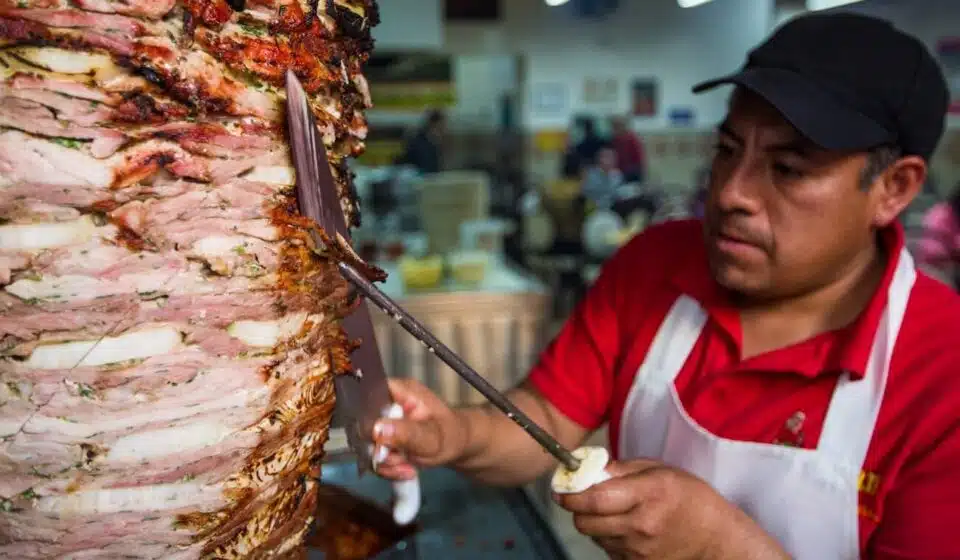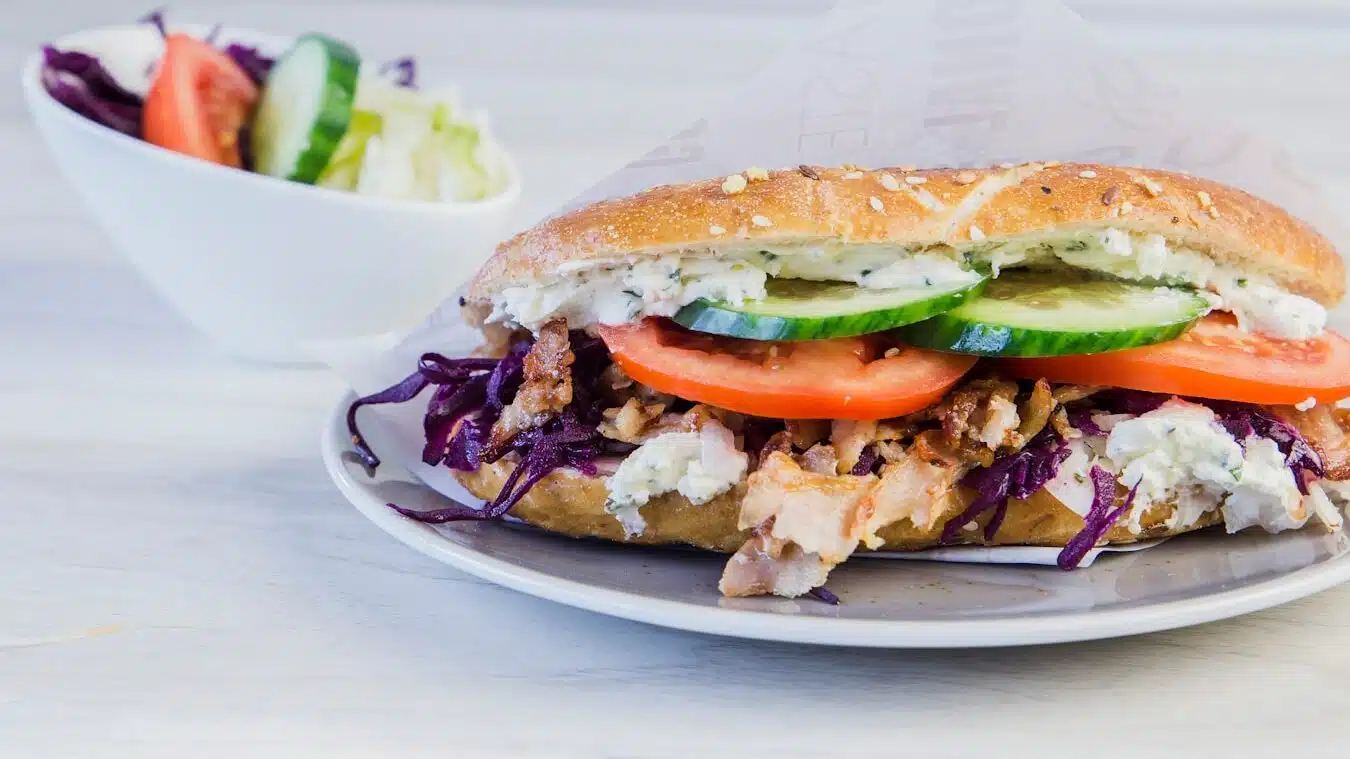
Doner Kebab: Meaning, History, Types, Ingredients, and Where to Eat
1. Definition & Meaning of Doner Kebab
What Is a Doner Kebab? Complete Guide for Beginners

A doner kebab is a popular Turkish dish made from thin slices of seasoned meat cooked on a vertical rotisserie. The meat is shaved off as it cooks and is typically served in flatbread, pita, or on a plate with sides like salad and rice. Known worldwide for its flavor and convenience, the döner kebab is a staple of street food culture in many countries.
Table Of Content
- 1. Definition & Meaning of Doner Kebab
- What Is a Doner Kebab? Complete Guide for Beginners
- Doner Kebab Meaning and Origin Explained
- What Does “Doner” Mean in Turkish Cuisine?
- Doner Kebab vs Döner: Is There a Difference?
- Defining Doner Kebab: A Turkish Culinary Icon
- 2. History & Cultural Background
- The History of Doner Kebab in Turkey and Beyond
- Is Doner Kebab Turkish? The Truth About Its Origin
- How Doner Kebab Became a Global Street Food Star
- From Ottoman Kitchens to Modern Streets: The Doner Story
- 3. Types & Variations
- Turkish Doner Kebab vs Shawarma: Key Differences
- Durum Kebab, Doner Plate, and More: Popular Serving Styles
- Beef, Chicken, or Lamb? Types of Doner Meat Explained
- Turkish Doner Sandwiches, Wraps, and Plates Compared
- 4. Ingredients & Preparation
- What Meat Is Doner Kebab Made Of?
- What’s in a Doner Kebab? Typical Ingredients List
- What Spices and Marinades Make Doner Meat Unique?
- How Doner Kebab Is Cooked: From Vertical Rotisserie to Plate
- 5. Popular Questions & FAQs
- 6. Dining & Travel
- Where to Eat the Best Doner Kebab in Turkey
- Iconic Döner Restaurants in Istanbul and Beyond
- Street Food Culture: Doner Kebab in Turkish Cities
- The Doner Plate Experience: What to Expect
- Related Posts
Doner Kebab Meaning and Origin Explained
The word doner comes from the Turkish verb dönmek, meaning “to turn” or “rotate.”
This is a direct reference to the continuous spinning of the vertical rotisserie during cooking, which ensures even heat distribution and maximum flavor.
The term doner kebab literally translates to “rotating grilled meat,” highlighting both the preparation method and the dish’s defining feature.
Its origin is deeply rooted in Ottoman cuisine, where vertical meat roasting became an art form and a symbol of culinary sophistication.
Over time, regional variations like kebap and shawarma emerged across the Middle East, each adapting the concept with local spices, marinades, and serving styles.
Key points about the term ‘doner’:
- Derived from Turkish, emphasizing rotation during cooking
- Associated with vertical spit-roasted meat
- Shares similarities with Middle Eastern and Mediterranean dishes
- Symbolizes a fusion of tradition and practicality in street food culture
What Does “Doner” Mean in Turkish Cuisine?
In Turkish culinary tradition, döner refers to meat prepared on a vertical spit, slowly roasted for maximum flavor. While doner kebab is the most famous form, the term “doner” can also describe variations like durum kebab (wrap form) or doner plate (served with rice and salad).
Doner Kebab vs Döner: Is There a Difference?
The difference between doner kebab and döner is mostly linguistic and cultural.
Key differences:
- Döner: The original Turkish word, meaning “rotating” or “turning,” used locally in Turkey.
- Doner kebab: The Anglicized version of the term, widely used in international contexts.
- Usage in Turkey: Simply saying döner is enough to order the dish, as it is a well-known staple.
- Usage abroad: The term doner kebab is often used to distinguish it from other kebab varieties.
| Term | Language/Origin | Common Usage Context |
|---|---|---|
| Döner | Turkish | Everyday ordering and menus in Turkey |
| Doner kebab | Anglicized | International menus, marketing, and global street food culture |
Defining Doner Kebab: A Turkish Culinary Icon
Today, doner kebab is not just food—it’s a cultural ambassador of Turkish cuisine. From Istanbul street stalls to restaurants worldwide, it has become one of the most recognized Turkish dishes globally.
2. History & Cultural Background
The History of Doner Kebab in Turkey and Beyond
The doner kebab traces its roots to the Ottoman Empire in the 19th century. Meat cooked on a horizontal spit was already popular, but chefs in Bursa revolutionized it by turning the spit vertical, creating the vertical rotisserie method used today.
Is Doner Kebab Turkish? The Truth About Its Origin
Yes, doner kebab is widely recognized as authentically Turkish in origin, with historical records and culinary traditions pointing to its development in the Ottoman Empire.
However, some food historians note that the concept of spit-roasting meat vertically may have older roots shared across several cultures in the Middle East and Mediterranean.
Similar dishes like shawarma (Middle East) and gyro (Greece) have their own distinct regional histories, seasoning profiles, and serving styles.
These similarities have led to ongoing debates among culinary experts about whether these dishes evolved independently in their respective regions or share a common culinary ancestor that adapted over time to local tastes and ingredients.
How Doner Kebab Became a Global Street Food Star
The global rise of doner kebab began when Turkish immigrants introduced it to Germany in the 1970s, particularly in Berlin. Initially prepared much like in Turkey, it was quickly adapted to suit local tastes and urban fast-food culture. Berlin’s signature version involved stuffing freshly shaved meat into bread—often pita or Turkish flatbread—layered with crisp salad, pickled vegetables, and a choice of sauces such as garlic, yogurt, or spicy chili. This portable, flavorful meal resonated with both locals and immigrants, becoming a late-night favorite and a symbol of multicultural street food. Over time, this Berlin-style doner kebab spread throughout Europe and eventually to other parts of the world, cementing its place as a global fast-food icon.
From Ottoman Kitchens to Modern Streets: The Doner Story
From royal feasts served in the opulent courts of the Ottoman Empire to the bustling street food stalls catering to late-night crowds, döner kebab has undergone a remarkable transformation over the decades. Its presentation, serving styles, and even spice blends have adapted to suit different cultures and tastes around the world, yet it continues to preserve the essential elements that define it—slow-roasted meat, aromatic seasoning, and the distinctive vertical rotisserie cooking method that captures its authentic flavor.
3. Types & Variations
Turkish Doner Kebab vs Shawarma: Key Differences
| Feature | Doner Kebab | Shawarma |
| Origin | Turkey | Middle East |
| Common Meats | Lamb, Beef, Chicken | Lamb, Beef, Chicken, Turkey |
| Seasoning Style | Lighter spices, often herb-based | Heavier marinades, rich in Middle Eastern spices |
| Cooking Method | Vertical rotisserie | Vertical rotisserie |
| Flavor Profile | Mild to moderately spiced | Stronger, more aromatic and spiced |
| Serving Styles | Wraps, plates, sandwiches | Wraps, plates, sandwiches |
While doner kebab and shawarma share similarities, doner typically uses lighter spice blends and often features lamb or beef, whereas shawarma leans toward heavier marinades and a bolder Middle Eastern spice mix.
Durum Kebab, Doner Plate, and More: Popular Serving Styles
- Durum kebab – rolled in flatbread, typically lavash or yufka, filled with freshly sliced doner meat, vegetables like lettuce, tomato, and onion, and topped with sauces such as yogurt, garlic, or chili. This portable option is a favorite for quick street food.
- Doner plate – served on a plate with generous portions of doner meat, accompanied by sides such as rice or bulgur pilaf, fresh salad, grilled vegetables, and a selection of sauces. Often enjoyed as a sit-down meal.
- Doner sandwich – served in pita bread or Turkish bread, filled with layers of doner meat, vegetables, and sauces. This option is popular in many countries and is known for its hearty, hand-held format.
Beef, Chicken, or Lamb? Types of Doner Meat Explained
| Meat Type | Texture | Flavor Profile | Notes | Best Pairings |
| Lamb | Tender, slightly fatty | Rich, savory, and aromatic | Considered the most traditional choice in Turkey | Works well with yogurt sauce, sumac onions, and fresh parsley |
| Beef | Firm, meaty | Robust and hearty | Popular for its strong flavor and satisfying bite | Pairs nicely with chili sauce, pickled vegetables, and lavash bread |
| Chicken | Soft, lean | Mild, light, and slightly sweet | Often chosen as a lower-fat, healthier option | Complements garlic sauce, lettuce, and cucumber for freshness |
The main meats used in doner kebab are lamb, beef, and chicken, each offering distinct textures and flavors. Lamb doner remains the most iconic and traditional in Turkish culinary culture, appreciated for its depth of flavor. Beef doner is often favored by those who prefer a heartier bite, while chicken doner is a lighter alternative that still delivers satisfaction. The seasoning, marination time, and accompaniments further shape the taste, making each meat option a unique experience.
Turkish Doner Sandwiches, Wraps, and Plates Compared
Whether you choose a doner wrap, doner plate, or doner sandwich, the main differences lie in the bread type, presentation, and accompaniments.
- Doner wrap (Durum): Uses lavash or yufka flatbread, rolled tightly with meat, vegetables, and sauces for easy on-the-go eating.
- Doner plate: Served on a plate with a generous portion of meat, rice or bulgur, fresh salad, and often grilled vegetables and bread on the side.
- Doner sandwich: Uses pita or Turkish bread, with meat layered inside along with vegetables, pickles, and sauces, offering a hearty hand-held option.
Each style offers a different texture, eating experience, and combination of flavors, making the choice a matter of personal preference and dining context.
4. Ingredients & Preparation
What Meat Is Doner Kebab Made Of?
A doner kebab can be made from lamb, beef, chicken, or a combination of these meats, depending on regional preference and customer taste. The choice of meat significantly affects the flavor profile:
- Lamb doner: Rich, aromatic, and considered the most traditional.
- Beef doner: Robust, hearty taste with a firm texture.
- Chicken doner: Lighter, mild, and often preferred as a healthier option.
- Mixed meat doner: Combines flavors and textures for a unique taste experience.
Preparation process:
- The meat is carefully sliced thin and layered with pieces of fat to ensure juiciness.
- It is marinated with a blend of spices and sometimes yogurt or oil to tenderize and flavor the meat.
- Layers are stacked onto a vertical spit, alternating lean cuts with fat for balanced cooking.
- The meat is slow-cooked over several hours, ensuring even cooking and maximum flavor retention.
High-quality cuts, proper marination, and a balanced fat-to-meat ratio are essential for achieving the signature tenderness and taste associated with authentic doner kebab.
What’s in a Doner Kebab? Typical Ingredients List
- Doner meat (lamb, beef, or chicken): The star of the dish, marinated and slow-cooked on a vertical rotisserie for hours until tender and juicy. High-quality cuts and a balanced fat-to-meat ratio ensure the perfect texture and flavor.
- Flatbread or pita: Soft, warm, and slightly chewy, perfect for wrapping around the meat and holding all the fillings together. Sometimes lightly toasted for added texture.
- Fresh vegetables (lettuce, tomato, onion, cucumber, cabbage, parsley): Crisp and refreshing, they provide a contrast to the richness of the meat and add vibrant color to the presentation.
- Sauces (yogurt, tahini, chili, garlic, tomato-based): These bring creaminess, tang, or spice, allowing for customization of flavor intensity. Often served on the side so diners can add to taste.
- Pickles (gherkins, pickled peppers, red cabbage): Add tang and crunch to balance the savory meat.
- Cheese (optional in some variations): Feta or kashar cheese for a creamy, salty twist.
- Herbs and spices garnish (sumac, mint, dill): Enhance aroma and freshness right before serving.
What Spices and Marinades Make Doner Meat Unique?
Common seasonings include cumin, paprika, oregano, and black pepper. The marinade often contains olive oil, garlic, and vinegar.
How Doner Kebab Is Cooked: From Vertical Rotisserie to Plate
Layering the Meat: The meat is stacked in layers on a vertical spit, carefully arranged to alternate lean cuts with layers of fat to maintain juiciness throughout the cooking process.
Cooking Process: It slowly rotates in front of a steady heat source—traditionally charcoal for a smoky aroma or gas burners for consistent heat—ensuring the outer layer cooks evenly while locking in moisture inside.
Slicing Technique: As the outer surface becomes perfectly browned and crisp, thin slices are expertly shaved off using a long knife or, in modern setups, an electric slicer to achieve uniform pieces.
Serving: These slices are served immediately to preserve their heat and texture, often placed directly into fresh bread or flatbreads for wraps, or arranged on plates alongside salads, grains, and sauces.
5. Popular Questions & FAQs
What is a doner wrap and how is it made?
A doner wrap, also called a durum kebab, is made by rolling thinly sliced doner meat in flatbread with fresh vegetables and sauces.
What’s the difference between kebab and doner?
Kebab is a general term for grilled meat dishes, while doner specifically refers to meat cooked on a vertical rotisserie.
Is doner kebab healthy or unhealthy?
It can be high in calories and fat, but using lean meat and fresh vegetables makes it healthier.
Why is doner kebab so popular worldwide?
Its rich flavor, quick preparation, and adaptability make it a global street food favorite.
What meat is most commonly used in doner kebab?
Traditionally lamb, though beef and chicken are also popular.
Is doner kebab the same as shawarma?
No—shawarma differs in spices, cuts, and origin.
What bread is used for doner kebabs?
Typically flatbread, pita, or lavash.
Can doner kebab be made at home?
Yes, with a rotisserie grill or oven.
What sauces pair best with doner kebab?
Yogurt-based sauces, tahini, and chili sauce.
Is doner kebab gluten-free?
Only if served without bread or with gluten-free bread.
Where did doner kebab originate?
Bursa, Turkey in the 19th century.
How long does it take to cook doner meat?
Several hours for a full rotisserie stack.
Can you freeze doner meat?
Yes, though it’s best fresh.
Is doner kebab spicy?
Usually mild, but sauces can add heat.
What vegetables are common in a doner wrap?
Tomato, lettuce, onion, and cucumber.
Is chicken doner healthier than lamb?
Generally lower in fat and calories.
How is doner meat sliced?
Thinly shaved from the rotating spit.
Can vegetarians enjoy doner kebab?
Yes, with plant-based meat substitutes.
What drink pairs well with doner kebab?
Ayran (yogurt drink) is traditional.
Are there regional variations in Turkey?
Yes, including Iskender kebab in Bursa.
What’s the calorie count of a typical wrap?
Around 600–900 calories.
Why is doner kebab filling?
High protein content and hearty bread.
What’s the difference between a doner plate and wrap?
A plate includes rice/bulgur and salad; a wrap is handheld.
Do Germans eat doner kebab differently?
Yes—often with cabbage and extra sauces.
6. Dining & Travel
Where to Eat the Best Doner Kebab in Turkey
Cities like Istanbul, Ankara, and Bursa are famous for their authentic döner kebabs, each offering unique regional styles.
| City | Signature Döner Style | Notable Features |
| Istanbul | Street-style döner served in wraps or sandwiches | Often paired with pickles, fresh salad, and a variety of sauces |
| Ankara | Thinly sliced döner served on plates with rice and grilled vegetables | Known for balanced seasoning and tender meat |
| Bursa | Iskender kebab (döner served over bread with tomato sauce and yogurt) | Rich, saucy, and often topped with melted butter |
This regional diversity allows travelers to experience different flavors and presentations of döner kebab across Turkey.otable spots include Kasap Osman in Istanbul, famous for its juicy and well-seasoned meat served fresh off the spit; Beyti Restaurant in Istanbul’s Florya district, renowned for its fine-dining twist on classic kebabs; and Tarihi Bursa Kebapçısı, which has been serving authentic Iskender kebab for decades. Each of these destinations offers a unique take on the beloved döner, making them must-visit locations for culinary travelers.
Iconic Döner Restaurants in Istanbul and Beyond
From small street stalls to luxury eateries, Istanbul döner restaurants offer a variety of experiences, each with its own charm, flavor profile, and service style.
| Restaurant Type | Typical Price Range | Atmosphere | Notable Features | Example Restaurants |
| Street Stall | Low | Casual, fast-paced | Quick service, authentic street flavor, affordable prices | Tarihi Karadeniz Döner, Dönerci Şahin Usta |
| Mid-Range Eatery | Moderate | Cozy, sit-down | Wider menu options, fresh sides, customizable sauces | Kasap Döner, Bayramoğlu Döner |
| Luxury Restaurant | High | Elegant, refined | Premium meat cuts, gourmet presentation, fine dining experience | Günaydın Kebap & Steakhouse, Nusr-Et Steakhouse |
This diversity allows both locals and tourists to enjoy döner kebab in settings that range from a quick street snack to an upscale culinary experience, with iconic names in each category offering memorable flavors and service.
Street Food Culture: Doner Kebab in Turkish Cities
In Turkish street food culture, doner kebab is one of the most accessible and beloved dishes, available in nearly every neighborhood, from bustling city centers to quiet side streets. It’s often prepared fresh throughout the day, ensuring that both locals and visitors can enjoy a hot, flavorful meal on the go. Street vendors typically serve it in wraps, sandwiches, or plates, and its affordability and speed make it a go-to choice for busy workers, students, and late-night diners. In many cities, the aroma of sizzling doner meat on a vertical rotisserie is a familiar and inviting sign that a satisfying meal is just steps away.
The Doner Plate Experience: What to Expect
A doner plate is a complete meal that offers variety and balance.
- Main Protein: It typically includes a generous serving of freshly sliced doner meat—options may include lamb for a rich, traditional flavor; beef for a hearty, robust taste; or chicken for a lighter, leaner choice.
- Grain Base: This is often accompanied by rice or bulgur pilaf, providing a warm and filling base that complements the savory meat.
- Fresh Salad: A seasonal salad of tomatoes, lettuce, cucumber, and onion adds crispness and freshness to the plate, balancing the richness of the meat.
- Bread Option: Many doner plates also include a warm piece of Turkish bread or pita, perfect for scooping up meat and salad or soaking up sauces.
- Additional Sides: Grilled vegetables like peppers and tomatoes bring a smoky sweetness, while pickled garnishes offer a tangy contrast.
- Sauces: A selection of sauces such as yogurt, garlic, or chili enhances flavor, allowing diners to customize each bite according to their taste preferences.
This combination makes the doner plate a satisfying, well-rounded dish that blends textures and flavors in every portion.

